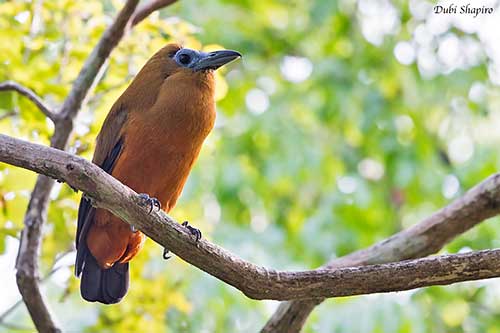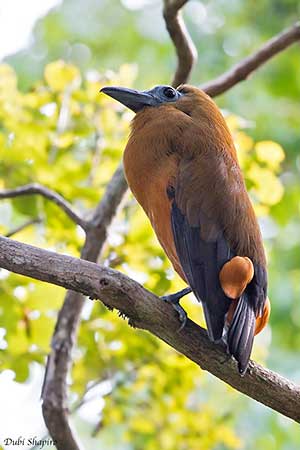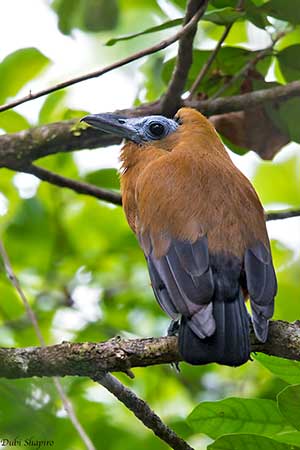
Fr: Coracine chauve
Ang: Capuchinbird - Calfbird
All: Kapuzinerkotinga
Esp: Pájaro-capuchino
Ita: Cappuccino
Nd: Capuchonvogel
Sd: kapucinfågel
Photographer:
Dubi Shapiro
Dubi Shapiro Photo Galleries & Dubi Shapiro's Pictures on IBC
Text by Nicole Bouglouan
Sources:
HANDBOOK OF THE BIRDS OF THE WORLD Vol 9 - by Josep del Hoyo - Andrew Elliot - David Christie - Lynx Edicions - ISBN: 8487334695
BIRDS OF SOUTH AMERICA – Passerines - by Robert S. Ridgely and Guy Tudor – HELM Field Guides – ISBN: 9781408113424
PORTRAITS D’OISEAUX GUYANAIS - Groupe d'étude et de protection des oiseaux en Guyane (GEPOG) - Ibis rouge éditions - ISBN: 2844501842
BIRDS OF VENEZUELA by Steven L. Hilty – Ed. Christopher Helm – ISBN: 0713664185
Wikipedia, the free encyclopaedia
Neotropical Birds – Cornell Lab of Ornithology
SORA Searchable Ornithological Research Archive (Blair O. Wolf)
NOTES ON THE BEHAVIOR OF THREE COTINGIDAE by BARBARA K. SNOW
CREAGUS@Monterey Bay (Don Roberson)
Home page
Page Passeriformes Order
Capuchinbird
Perissocephalus tricolor
Passeriformes Order – Cotingidae Family
INTRODUCTION:
The Capuchinbird is also named « Calfbird » due to the sound of its call, a loud mooing produced by the male. This unmistakable, strange-looking cotinga is usually quite solitary and inconspicuous within the humid forest of north-eastern South America. However, their weird songs can be heard during the displays at leks in the upper canopy of tall trees, during which their peculiar plumage pattern is enhanced by adapted postures. They nest in trees and feed on fruits and large insects.
The Capuchinbird is uncommon throughout its range. It is affected by habitat loss due to deforestation, but the species is currently not globally threatened.
DESCRIPTION OF THE BIRD:
Biometrics:
Length: 35 cm
The Capuchinbird has chestnut brown back of head, upperparts and underparts with some variations.
On the upperparts, upperwing and uppertail coverts are dark brown whereas flight-feathers and rectrices are almost blackish.
The underparts are more rufescent with orange-rufous undertail-coverts. These feathers are long and curled, and they are raised during the displays. The underwing coverts are white.
The head is bald with blue-grey bare skin extending from crown and face to the lower part of the bill. On the back of the head, the feathers are dense and upstanding, forming a strange hood and a ruff around the head during the displays. The bare head looks small, involving a unique silhouette.
The bill is heavy with dark grey upper mandible and mostly bluish-grey lower mandible, whereas the base is paler and bluer grey. The eyes are dark brown. Legs and feet are blue grey.
Male and female have similar plumage, but the female is slightly smaller than male.
The juvenile shows sparse downy feathers on the bare skin of the head, but globally, it resembles adults.

RANGE:
The Capuchinbird is found in extreme E Colombia, S and E Venezuela, the Guianas and N Brazil, N of Amazon.
HABITAT:
The Capuchinbird is usually found in the lowlands where it frequents the canopy of tropical evergreen forest.
The species is usually visible below 600 metres, but it can be seen up to 1,400 metres of elevation in the mountains of Venezuela.
CALLS AND SONGS: SOUNDS BY XENO-CANTO
The Capuchinbird produces an extraordinary deep sound, a far-carrying mooing call very similar to the lowing of a calf. This call is uttered by males at their leks, and given with the bill open “ooo-AAAAA, ooo-AAAAA”.
We can also hear a soft guttural “ouueeeg”. The female gives rasping “waaaaa” or “kack” in alarm. The contact call is a quiet growling “wark” given while foraging.
BEHAVIOUR IN THE WILD:
The Capuchinbird feeds on fruits and large insects. The bird plucks the fruits while flying, and regurgitates the seeds while perched in the shade. Insects are caught on foliage. It perches motionless in order to scan the vegetation, and as soon as the prey is located, it flies and snatches it of foliage.
During the breeding season, the Capuchinbird displays at leks. The site of the lek changes from year to year and the dominant male has to establish its dominance each season. A display area consists mainly of trees of about 25 metres high or less. The leks are usually in the upper canopy of the tall trees of the rainforest.
The dominant male defends its perch while other males display nearby. The males stand upright with conspicuous bald head, while the curled orange-rufous undertail-coverts are raised and appear on each side of the dark tail. The birds produce a growling “grrr” by inhalation of air through the open bill. Then, they puff up all the upperpart feathers, assuming slowly an upright posture followed by a leaning-back posture. The tail is fanned and depressed, enhancing the tufts of the undertail-coverts. They produce an “aaa” call. Then, the “moo” call is given during the puffed-up/leaning-back posture. As the bill is closed during the mooing call, the air could be blown out through the gape. The full sequence is described as “grrr-aaa-oooooo”.

The subordinate males continually attempt to occupy the perch of the dominant male through paired displays during which they perch side to side and call alternately.
The females visit the lek in groups and some of them can be very aggressive towards one another, often leading to chaos. The females compete between females, while males compete between males.
The monomorphism of the Capuchinbird is a rare characteristic in species using leks. This complex lekking behaviour is only partially understood, and all these displays currently remain a mystery.
The Capuchinbird is probably resident and any movement has been reported.
REPRODUCTION OF THIS SPECIES:
The breeding season varies according to the range. The laying occurs in February/April in Guyana, in November/March in Surinam and July and October in French Guiana.
The nest is a thin, light platform made with bifurcating twigs, with a shallow cup made of finer twigs of Eugenia trees. It is placed in tree, between 3 and 6 metres above the ground, usually fairly close to the lek.
The female lays a single egg and incubates during 26-27 days. The young bird fledges about four weeks after hatching.
The female alone does all the nesting duties.
PROTECTION / THREATS / STATUS:
The Capuchinbird is uncommon to locally common throughout the range, and the birds are usually concentrated around the leks. The species occurs in several protected areas, but it is suspected to lose progressively its suitable habitat through deforestation.
The population is declining but currently, the Capuchinbird is still evaluated as Least Concern.
